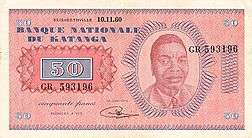Katangese franc
The Katangese franc was the currency of the unrecognized State of Katanga between 1960 and 1963 during its brief period of independence from the Republic of the Congo. It replaced the Congolese franc at par and was consequently initially equal to the Belgian franc. This established an exchange rate of 50 francs = 1 U.S. dollar. Just before Katanga was re-annexed by Congo, the exchange rate had fallen to 195 francs = 1 U.S. dollar. The currency was replaced at par by the Congolese franc.
| Katangese franc | |
|---|---|
| franc katangais(in French) | |
 1960 50 francs | |
| Denominations | |
| Subunit | |
| 1/100 | centime |
| Banknotes | 10, 20, 50, 100, 500 and 1,000 francs |
| Coins | 1, 5 francs |
| Demographics | |
| User(s) | Katanga |
| Issuance | |
| Central bank | Banque Nationale du Katanga |
This infobox shows the latest status before this currency was rendered obsolete. | |
Coins
Bronze coins were issued in 1961 in denominations of 1 and 5 francs. A non-circulating gold 5 francs coin was also issued for collectors. Only one set containing 1 francs and 5 francs were ever made, and they remain readily available to collectors at nominal cost. Their design shows a copper cross, which was locally used for money in precolonial times.[1][2]
Banknotes
In 1961, a provisional issue of notes was produced by the government. These were overprinted on notes of the Rwanda and Burundi franc in denominations of 5, 10, 20, and 50 francs. On 9 January 1961, regular notes dated 31.10.60 were issued by the Banque Nationale du Katanga in denominations of 10, 20, 50, 100, 500 and 1000 francs. A second series of notes was also issued dated 1962 and 1963 in denominations of 100, 500, and 1000 francs.[3]
| Banknotes of the Katangese franc (1960 Moise Tshombé issue) | ||||
|---|---|---|---|---|
| Image | Value | Obverse | Reverse | |
| 10 francs | Moise Tshombé | National Assembly ("Bâtiment du 30 Juin"), Élisabethville (Lubumbashi) | ||
| 20 francs | Moise Tshombé | National Assembly ("Bâtiment du 30 Juin"), Élisabethville (Lubumbashi) | ||
| 50 francs | Moise Tshombé | National Assembly ("Bâtiment du 30 Juin"), Élisabethville (Lubumbashi) | ||
| 100 francs | Moise Tshombé | National Assembly ("Bâtiment du 30 Juin"), Élisabethville (Lubumbashi) | ||
| 500 francs | Moise Tshombé | National Assembly ("Bâtiment du 30 Juin"), Élisabethville (Lubumbashi) | ||
| 1000 francs | Moise Tshombé | National Assembly ("Bâtiment du 30 Juin"), Élisabethville (Lubumbashi) | ||
References
- Anderson, Joel. "The Katanga Cross". www.joelscoins.com. Retrieved 2017-09-17.
- Coins from Katanga
- Linzmayer, Owen (2012). "Katanga". The Banknote Book. San Francisco, CA: www.BanknoteNews.com.
Further reading
- Boehme, Olivier (2005). "The Involvement of the Belgian Central Bank in the Katanga Secession, 1960-1963". African Economic History. 33: 1–29. JSTOR 4617603.
| Preceded by: Congolese franc Reason: independence Ratio: at par |
Currency of Katanga 1960 – 1963 |
Succeeded by: Congolese franc Reason: reunification Ratio: at par |